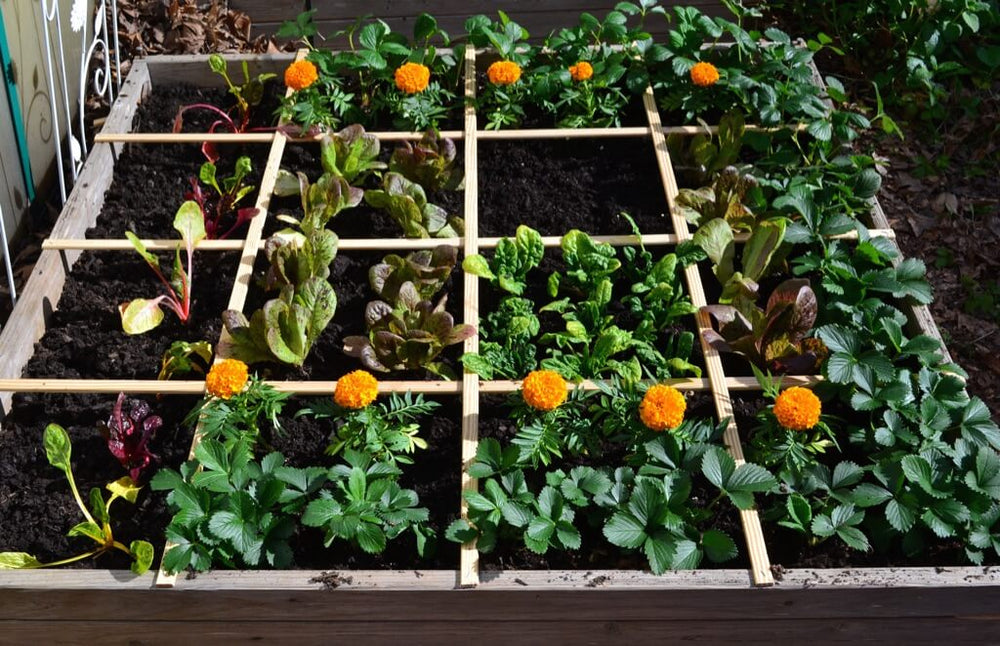When we imagine growing food, we often think of neat rows, planted in straight lines, occupying lots of land. But in 1975, backyard gardening enthusiast Mel Bartholomew was looking for a more space-efficient way to grow food. He applied his engineering background to develop a new gardening method called "square foot gardening," which he turned into a best-selling book and popular television show. Today, more than 2 million gardeners use the square foot gardening method. But is it right for you? Let's take a look.
What Is Square Foot Gardening?
Square foot gardening is exactly what the name says: dividing a growing area into 1-foot x 1-foot sections. In a true square foot garden, an actual grid is placed on the growing area to divide up the space. What you grow in each section depends on the mature size of the crop. Some sections will house 16 small plants, like radishes, or only 1 plant, like a cabbage. Check out these examples:
Plant 1 per square foot
Plant 2 per square foot
Cucumbers (vining, trellised)
Summer squash (trellised)
Plant 4 per square foot
Plant 9 per square foot
- Bush beans
- Peas
- Spinach
- Beets
Plant 16 per square foot
- Carrots
- Radishes
- Green onions



The same universal gardening principles still apply to square foot gardening. You need a site with plenty of sun, easy access to water, and good soil Miracle-Gro® Raised Bed Soil is an excellent choice, as it provides an ideal environment for plant roots). Square foot gardening also works best in a raised bed that's no more than 4 feet wide (so you can reach the middle easily), though it can be whatever length you like.
Now, let's look at the pros and cons of square foot gardening.
Benefits of Square Foot Gardening
For new gardeners, square foot gardening offers a simple vegetable garden layout that makes it easy to calculate exactly how many plants you need. It's also a handy solution for gardeners with limited room to grow, since the intensive planting style lets you plant more plants in less space. A square foot garden is also relatively low maintenance, since it leaves little room for weeds.
Drawbacks of Square Foot Gardening
Some crops, like large, indeterminate tomatoes, need more space than a single square foot—otherwise they'll start stealing nutrients and water from other plants. Plus, plants can deplete moisture and nutrients quickly in a square foot garden due to the intensive planting technique. Feeding your plants regularly with Miracle-Gro® Shake ‘n Feed® Tomato, Fruit & Vegetable Plant Food will help provide the nutrition they'll need in order to produce a big harvest. Also, be sure to water whenever the top inch of soil is dry.
It's worth noting, too, that traditional square foot gardens are only 6 inches deep, which is too shallow for many plants. Vegetables need plenty of space to stretch their roots and absorb nutrients from the soil. If you choose to try this method, make your beds at least 12 inches deep to allow lots of room for the roots.
How to Tweak Your Square Foot Garden for Success
So, how can you benefit from the helpful aspects of square foot gardening while modifying the approach to fit your needs? Try one of these ideas:
Mix and match. Choose multiple plant types from the same category to give you more flexibility over what to grow in the space you have. For example, instead of planting a square with 4 lettuces, plant 2 lettuce plants and 2 marigolds, which not only attract pollinators but also add a pretty accent to the garden. Or, since you can fit 4 strawberry or 4 basil plants in one square foot, combine 2 of each of the plants in each of the outermost squares to create a lovely edible border around the inside perimeter of the bed.
Think small. Rather than planting a large tomato plant that would require more nutrients and water than are available in a single square foot, choose a smaller dwarf or bush variety, like Better Bush, that can flourish in less space.
Grow up. Adding a trellis to your square foot garden is a perfect way to increase available growing space and vines off the ground. Do this for peas, pole beans, cucumbers, melons, and squash. The easiest way is to attach the trellis to the back of the bed and use the back row of squares for the plants to be trellised.
So, no matter whether you appreciate a highly-organized planting plan for your raised bed or prefer a tad more creative approach, a little tweaking to the square foot gardening approach, plus some extra attention when it comes to watering and feeding, can lead to an impressive harvest. Enjoy your planning and planting!
Article and images by Julie Thompson-Adolf.





 Herbs
Herbs
 Vegetables
Vegetables
 Fruit
Fruit
 Flowers
Flowers
 Succulents
Succulents

